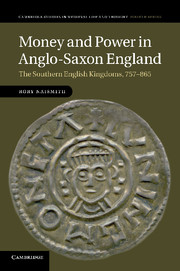Book contents
- Frontmatter
- Contents
- Figures
- Maps
- Tables
- Acknowledgements
- Abbreviations
- Chapter 1 Introduction
- Chapter 2 Money in its political context
- Chapter 3 Looking at coinage: iconography and inscriptions
- Chapter 4 Authority and minting I: the king
- Chapter 5 Authority and minting II: mints, die-cutters and moneyers
- Chapter 6 Value judgements: weight and fineness
- Chapter 7 Production of coinage
- Chapter 8 The circulation of coinage
- Chapter 9 The nature of coin-use in the early Middle Ages
- Chapter 10 Conclusion
- Bibliography
- Index
Chapter 7 - Production of coinage
Published online by Cambridge University Press: 07 October 2011
- Frontmatter
- Contents
- Figures
- Maps
- Tables
- Acknowledgements
- Abbreviations
- Chapter 1 Introduction
- Chapter 2 Money in its political context
- Chapter 3 Looking at coinage: iconography and inscriptions
- Chapter 4 Authority and minting I: the king
- Chapter 5 Authority and minting II: mints, die-cutters and moneyers
- Chapter 6 Value judgements: weight and fineness
- Chapter 7 Production of coinage
- Chapter 8 The circulation of coinage
- Chapter 9 The nature of coin-use in the early Middle Ages
- Chapter 10 Conclusion
- Bibliography
- Index
Summary
Coinage and recoinage
Among the many provisions of the Edict of Pîtres laid down in June 864 was one in which Charles the Bald stipulated ‘ut ab ipsa missa sancti Martini per omne regnum nostrum non nisi istius nostrae novae monetae meri et bene pensantes denarii accipiantur’. This has been connected by numismatists with a major reform of the currency which swept away the earlier coinages of diverse design and inconsistent metallic quality in favour of the Gratia Dei rex issue. Just as Charles commanded, west Frankish hoards from 864 onwards quickly came to be dominated by the new coinage. His measure, so it seemed, had been a success.
What Charles implemented in 864 is the classic example of what numismatists have called a renovatio monetae: a reform of the coinage in which the old currency was demonetized in favour of a new one. The roots of the policy go back to ancient times, and it can be traced in various proclamations of late Roman and Byzantine emperors. In the context of a precious-metal coinage this meant melting down the old coins and having them restruck throughout the kingdom. Charles the Bald’s 864 recoinage was not the only one to work along these lines, but it is among the best-recorded. It combines a clear monetary impact with relatively detailed documentation, and its provisions have been tentatively assumed to apply to many other times and places in the early Middle Ages.
- Type
- Chapter
- Information
- Money and Power in Anglo-Saxon EnglandThe Southern English Kingdoms, 757–865, pp. 181 - 198Publisher: Cambridge University PressPrint publication year: 2011



